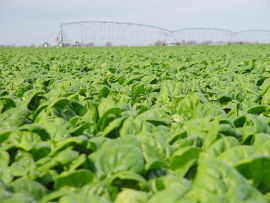Sweet discovery in leafy greens reveals how sulphur is used by living organisms
Posted on 15 February 2016
 Each year, leafy green vegetables – such as spinach – produce the sugar sulfoquinovose on an enormous scale globally. Picture credit: AgriLife Today
Each year, leafy green vegetables – such as spinach – produce the sugar sulfoquinovose on an enormous scale globally. Picture credit: AgriLife Today
A team of researchers including scientists from the Department of Chemistry at the University of York identified a previously unknown enzyme used by bacteria, fungi and other organisms to feed on the unusual but abundant sugar sulfoquinovose – SQ for short – found in green vegetables.
Each year, leafy green vegetables – such as spinach – produce the sugar on an enormous scale globally, comparable to the world’s total annual iron ore production.
The research, supported by Biotechnology and Biological Sciences Research Council and the European Research Council, , was led by Professor Gideon Davies of the York Structural Biology Laboratory (YSBL), Dr. Ethan Goddard-Borger from the Walter and Eliza Hall Institute and Professor Spencer Williams from the Bio21 Institute and University of Melbourne. It is published today in the journal Nature Chemical Biology.
Professor Davies said: “Plants make about ten billion tons of SQ annually. We finally know the key chemical steps in the assimilation of the sulphur and we can now see that these pathways are far more widespread than originally thought."
Dr Goddard-Borger said the discovery could be exploited to cultivate the growth of ‘good’ gut bacteria. “Every time we eat leafy green vegetables we consume significant amounts of SQ sugars, which are used as an energy source by good gut bacteria,” he said.
“Bacteria in the gut, such as crucial protective strains of E. coli, use SQ as a source of energy. E. coli provides a protective barrier that prevents growth and colonisation by bad bacteria, because the good bugs are taking up all the habitable real estate,” Dr Goddard-Borger said.
“E. coli is a key bacterial coloniser needed by our gut. We speculate that consumption of this specific molecule within leafy greens will prove to be an important factor in improving and maintaining healthy gut bacteria and good digestive health.”
Professor Williams said the team had revealed how bacteria extract the sugar from plants in order to fuel their growth. “We discovered the enzyme YihQ, which is used by bacteria to absorb and metabolise these sulphur-containing sugars as food,” he said.
“Sulphur is critical for building proteins, the essential components of all living organisms. SQ is the only sugar molecule which contains sulphur, and ‘digestion’ of the molecule by bacteria releases sulphur into the environment, where it re-enters the global ‘sulphur cycle’ to be reused by other organisms.”
Professor Williams said that the pathway was unusual, but abundant in biological organisms.
“This work answers a 50-year mystery that has surrounded how sulphur – an element essential for life on Earth – was used and recycled by living organisms,” he said. “What is remarkable is that the YihQ enzyme was hiding in plain sight and is produced by the humble bacterium E. coli, present in nearly every biologist’s laboratory.”
Further information:
The paper: 'YihQ is a sulfoquinovosidase that cleaves sulfoquinovosyl diacylglyceride sulfolipids' is published in Nature Chemical Biology
- For more information about the York Structural Biology Laboratory in the Department of Chemistry at the University of York, please visit: http://www.york.ac.uk/chemistry/research/ysbl/
- The research was supported by the National Health and Medical Research Council, Australian Research Council, Ramaciotti Foundation, veski, the Victorian Government Operational Infrastructure Support Program, UK Biotechnology and Biological Sciences Research Council and the European Research Council.
Explore more news

Poor diets fuelling health crisis in the North, report reveals
Wednesday 23 July 2025

Nightjars at real risk from decreasing genetic diversity, researchers warn
Tuesday 22 July 2025

A ‘millet mystery’ in ancient Japan reveals a complex picture of agricultural adoption, research shows
Monday 21 July 2025

Wednesday's child is not "full of woe," new study finds, debunking popular nursery rhyme
Wednesday 16 July 2025

Optical telescope on York rooftop to advance communication between space and earth
Wednesday 16 July 2025
